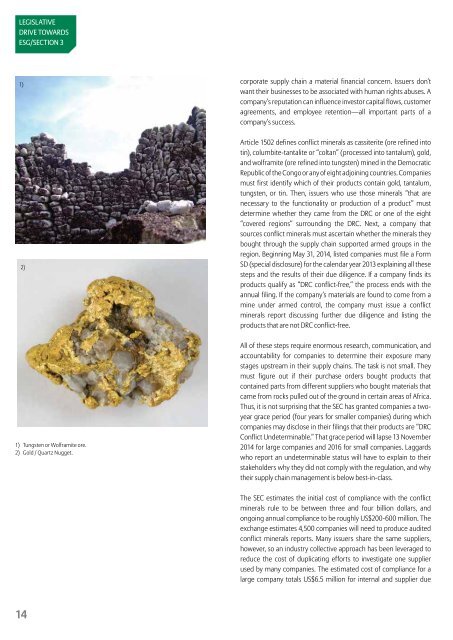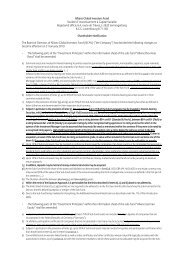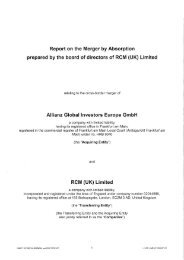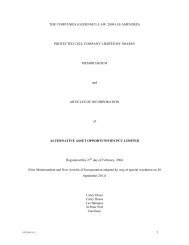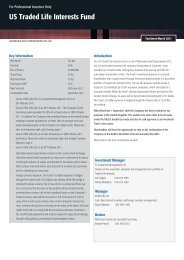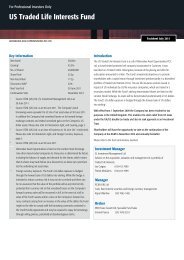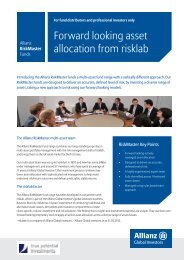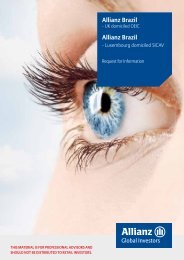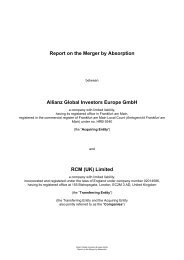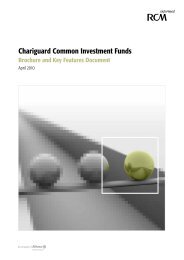ESG Matters, Issue 5, April 2013 - Allianz Global Investors
ESG Matters, Issue 5, April 2013 - Allianz Global Investors
ESG Matters, Issue 5, April 2013 - Allianz Global Investors
You also want an ePaper? Increase the reach of your titles
YUMPU automatically turns print PDFs into web optimized ePapers that Google loves.
legislativedrive towardsesg/section 31)2)corporate supply chain a material financial concern. <strong>Issue</strong>rs don’twant their businesses to be associated with human rights abuses. Acompany’s reputation can influence investor capital flows, customeragreements, and employee retention—all important parts of acompany’s success.Article 1502 defines conflict minerals as cassiterite (ore refined intotin), columbite-tantalite or “coltan” (processed into tantalum), gold,and wolframite (ore refined into tungsten) mined in the DemocraticRepublic of the Congo or any of eight adjoining countries. Companiesmust first identify which of their products contain gold, tantalum,tungsten, or tin. Then, issuers who use those minerals “that arenecessary to the functionality or production of a product” mustdetermine whether they came from the DRC or one of the eight“covered regions” surrounding the DRC. Next, a company thatsources conflict minerals must ascertain whether the minerals theybought through the supply chain supported armed groups in theregion. Beginning May 31, 2014, listed companies must file a FormSD (special disclosure) for the calendar year <strong>2013</strong> explaining all thesesteps and the results of their due diligence. If a company finds itsproducts qualify as “DRC conflict-free,” the process ends with theannual filing. If the company’s materials are found to come from amine under armed control, the company must issue a conflictminerals report discussing further due diligence and listing theproducts that are not DRC conflict-free.1) Tungsten or Wolframite ore.2) Gold / Quartz Nugget.All of these steps require enormous research, communication, andaccountability for companies to determine their exposure manystages upstream in their supply chains. The task is not small. Theymust figure out if their purchase orders bought products thatcontained parts from different suppliers who bought materials thatcame from rocks pulled out of the ground in certain areas of Africa.Thus, it is not surprising that the SEC has granted companies a twoyeargrace period (four years for smaller companies) during whichcompanies may disclose in their filings that their products are “DRCConflict Undeterminable.” That grace period will lapse 13 November2014 for large companies and 2016 for small companies. Laggardswho report an undeterminable status will have to explain to theirstakeholders why they did not comply with the regulation, and whytheir supply chain management is below best-in-class.The SEC estimates the initial cost of compliance with the conflictminerals rule to be between three and four billion dollars, andongoing annual compliance to be roughly US$200-600 million. Theexchange estimates 4,500 companies will need to produce auditedconflict minerals reports. Many issuers share the same suppliers,however, so an industry collective approach has been leveraged toreduce the cost of duplicating efforts to investigate one supplierused by many companies. The estimated cost of compliance for alarge company totals US$6.5 million for internal and supplier due14


